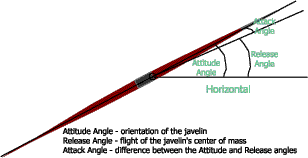
Javelin Throw
Tracey Kobayashi
50 Phelan Ave, NGYM
San Francisco, CA 94112
(415)452-7311
tkobayas@ccsf.edu
PE 9A: Fit or Fat
College & Career Ed
PE 50: Fitness Center

IM Me!
AIM - TKatCCSF
Yahoo - tkobico
ICQ - 155909399
Updated by Tracey 5 November 2001
Track & Field page |
Intro
Sprinting |
Long Jump |
High Jump
Javelin
The Javelin Throw is considered by many coaches to be a technical event. Since the javelin is relatively aerodynamic, throwing technique can influence the range of the javelin to a greater degree than with other throwing events..it's difficult to add range to a throw with brute force and still have the implement land legally! As you may have already noticed, it's a lot more difficult to throw the javelin well with even a short run than it is to just stand and throw it -- this event requires a delicate balance of speed, strength, and finesse!
You can watch videos of elite throwers at Throwers Video Clip Archive. Leichtathletik also has some interesting track & field animations.
As you know from class, there are three basic grips you can use with the javelin -- the thumb and first finger, thumb and second finger (or Finnish), and the fork grips. Although the thumb and first finger grip may feel more "comfortable," the Finnish and Fork grips actually make it easier for the javelin to lie correctly in the hand. Why is this important? Think about how difficult it is to get the javelin to fly in a straight line when you try to throw -- most of you had little whirly things happening, right? Well, small things such as the position of your hand, or the way the javelin lies in your hand, can influence the flight quite a bit, which is why it's also important to release from overhead and not out to the side.
All of the things you do in the process of throwing the javelin result in a set of release conditions that in turn result in a certain range. These can be broken down in a two-dimensional sense into a set of angles...

So...if you don't completely torque out the javelin laterally, then the javelin will look something like the picture above when viewed from the side. How it looks at the moment of release influences the pitch and ultimately the range. This means that for a given release velocity, the javelin will fly different ranges depending on the various release factors including its orientation (attitude angle), release angle, and rotational velocity. Of course, this is less so now than before 1987 when the rules changed -- they used to be a lot MORE aerodynamic!
Track & Field page |
Intro
Sprinting |
Long Jump |
High Jump
Javelin